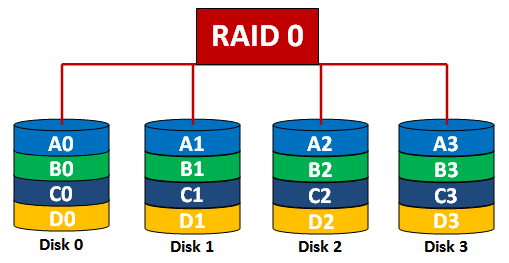RAID 0 - Striping

In a RAID 0 system data is split up into blocks that get written, striped, across all the drives in the array. By using multiple disks at the same time, the system has enhanced read and write speeds. This performance can be enhanced further by using multiple controllers. There are advantages to this type of RAID. It is easy to implement, access to data is faster, and all storage capacity is used since there is no overhead. However, contrary to common perception, a RAID 0 is NOT fault tolerant. If one drive fails, all data in the RAID 0 array is inaccessible. It should not be used for mission-critical systems.
RAID 0 is ideal for non-critical storage of data that has to be read and/or written at a high speed, such as on an image retouching or video editing station. Gamers use RAID 0 for quick access to gaming data.
Data Recovery from a Failed RAID 0
The sad truth about most RAID 0 systems out there is that they are usually set up with the expectation of redundancy. Funny that the acronym RAID stands for Redundant Array of Independent Drives but a RAID 0 has none. But there is hope for recovering data, even if there is no access to data. However, it is much more difficult than recovery from other types of RAIDs.
The first thing we do is assess each individual drive. Once the initial problem for each drive has been bypassed, we make a sector by sector clone of each drive using a tool specifically designed for this process. We then take these clones and rebuild the RAID in a virtual environment. A process that takes a highly skilled engineer and more specifically designed equipment and software to accomplish.
We then have access to data that can be tested for integrity and functionality.




